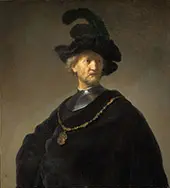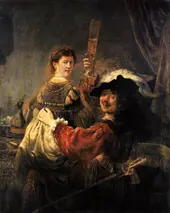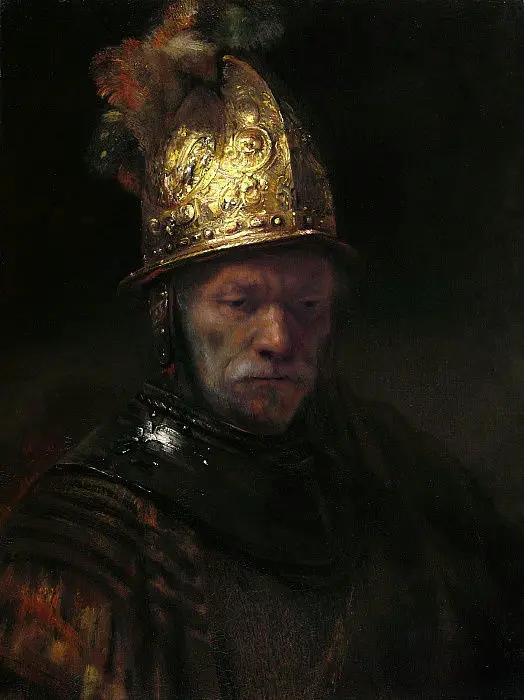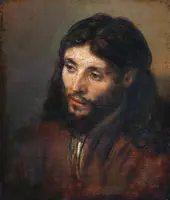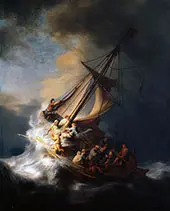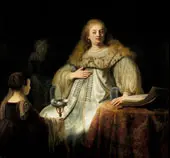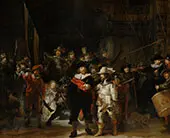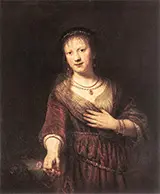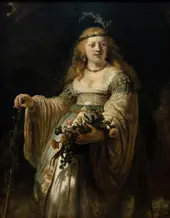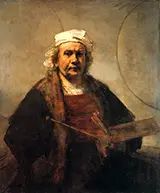Rembrandt Van Rijn Oil Painting Reproductions
Rembrandt Van Rijn replica paintings on Canvas for sale
Paintings by Rembrandt
Rembrandt van Rijn is a Dutch Golden Age artist who was born in July 1606 and died in October 1669.
Known simply as Rmbrandt, and considered one of the greatest visual artists in history and the most influential artist in Dutch art history. Rembrandt was a master draughtsman and printmaker, as well as a painter. Rembrandt's paintings contain varied subjects, from portraits and self-portraits to landscapes and biblical scenes, mythological scenes, animal studies, and landscapes.
Like Vermeer, another Dutch Golden Age artist, Rembrandt never left his native Holland. However, he was influenced by the Italian masters and by other Dutch artists who had been to Italy to study, such as Pieter Lastman and Peter Paul Rubens.
Where did Rembrandt van Rijn live?
Rembrandt was born in Leiden to a well-off family. His father was a prosperous miller who sent the young Rembrandt to the University of Leiden. He showed an interest and great aptitude for painting and studied as an apprentice to a Leiden history painter, Jacob van Swanenburg.
Rembrandt had a brief but important six months apprenticeship with Pieter Lastman in Amsterdam. In 1629 Rembrandt’s paintings were noticed by the Dutch statesman Constantijn Huygens. Huygens introduced the young Rembrandt to Prince Frederick Hendrik, a Prince of Orange, who purchased many Rembrandt paintings over many years.
Rembrandt, A Move to the Hague
In 1631, Rembrandt moved from The Hague to Amsterdam, where he succeeded as a professional portrait painter.
In 1634 he married Saskia van Uylenburgh in 1634. With the success of Rembrandt’s portrait paintings, the couple purchased a newly built house in the smart Breestraat area, a prominent Jewish quarter of Amsterdam.
Today, the house is the Rembrandt Museum House. The building has undergone restoration with interiors similar to those of Rembrandt’s time.
When Saskia died in 1642, Rembrandt had an affair with the woman hired to look after his son Titus when his wife was ill. However, he married a much younger woman with whom he had one daughter.
At the time, Rembrandt found himself in financial difficulty and habitually spent more than his considerable income. His worsened financial circumstances prompted a move to a smaller property in a less affluent part of Amsterdam.
Why is Rembrandt famous?
In the early 20th century, scholars estimated that Rembrandt had painted over 600 paintings, 400 etchings, and 2,000 drawings. However, experts have significantly reduced the number of Rembrandt’s paintings in recent years. For example, the original estimation is that he painted some 90 self-portraits. It now seems that the figure is more likely to be about 40 painted by Rembrandt, as he often tasked his students to paint his portrait.
Rembrandt’s famous paintings are in museums and private collections worldwide. The most extensive collections are in the Rijksmuseum in Amsterdam and the Mauritshuis in The Hague. Other notable collections are at the Hermitage Museum in St Petersburg, the National Gallery in London, The Louvre in Paris, the Frick Collection and the Metropolitan Museum of Art in New York City, The National Gallery of Art in Washington, D.C., the Museum of Fine Arts in Boston, and the J. Paul Getty Museum in Los Angeles.
The Night Watch by Rembrandt
Rembrandt’s most famous painting is The Night Watch 1642. The painting is in the collection of the Amsterdam Museum but is on display at the Rijksmuseum. It is the museum’s most famous painting and one of the most famous Dutch Golden Age paintings.
The painting is notable for its vast size – nearly 12 feet long and over 14 feet wide – with the central figures being roughly life-sized.
In 1716 the canvas was trimmed as part of the transportation process for its display at Amsterdam Town Hall. Unfortunately, the cut canvas has resulted in the loss of 34 original figures.
Rembrandt’s Night Watch took three years to paint.
Rembrand Famous Paintings
Rembrandt’s The Jewish Bride, 1667, shows a father giving his daughter a necklace on her wedding day. The painting is part of the Permanent Collection at The Rijksmuseum in Amsterdam.
Bathsheba at Her Bath 1654 shows the Biblical King David seeing Bathsheba bathing and seducing her. The Louvre holds the painting in Paris.
The Man with the Golden Helmet was painted in 1650 and held by the Gemaldegalerie in Berlin. It is another classic example of the Dutch Golden Age.
Danae was painted in 1636 and showed the mythological figure Danae meeting Zeus in the form of a shower of gold. The painting is in the collection of the State Hermitage Museum in St Petersburg.
Self Portrait with Beret and Turned Up Collar is one of many of Rembrandt’s self-portraits. The painting was completed in 1659 and is held by the National Gallery of Art in Washington, D.C.
Belshazzar’s Feast 1635 is Rembrandt showing his ability to paint large baroque-style historical paintings and is in the National Gallery of London collection.
The Anatomy Lesson of Dr. Nicolaes Tulp 1632 is considered an early Rembrandt masterpiece.
Self Portrait with Two Circles. This oil on canvas painting is considered his greatest self-portrait. Rembrandt painted the portrait between 1665 and 1669. Rembrandt is wearing a white hat and red bib over a white shirt and a fur coat with his palette and brush. The meaning of the two circles is unknown.
Rembrandt Religious Paintings
The Storm on the Sea of Galilee 1633. This painting is Rembrandt’s only known Seascape and was stolen in 1990 from the Isabella Stewart Gardner Museum in Boston. The painting illustrates the miracle of Jesus calming the storm. Unfortunately, it is still missing.
The Head of Christ 1648 is based on a Jewish model who was one of Rembrandt’s neighbors. The painting belongs to the Gemaldegalerie in Berlin.
The Prodigal Son in a Brothel 1637. The two figures in the painting are Rembrandt himself and his wife, Saskia. This oil painting on canvas is in the ownership of The Gemaldegalerie Alte Meister in Dresden.
The Return of the Prodigal Son 1661 – 1669 is one of Rembrandt’s final paintings before his death. This painting illustrates the famous Biblical parable held in the State Hermitage Museum in St Petersburg.
Buy hand-painted oil on canvas art.
Enjoy browsing our extensive catalog of art reproductions of Rembrandt van Rijn, the most famous Dutch Golden Age painter.
Testimonial from Joseph M Bruno, Tempest Golf Club, Gladewater, Texas
Cannot Find What You Are Looking For?
Reproduction Gallery Information
Customer Service
(Send Us A Message)
Tel: (302) 513 3464




